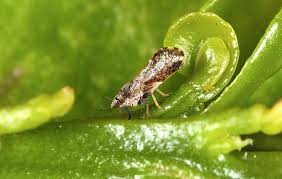 For nearly sixty years the United States has dodged infestation by the Asian citrus psyllid, one of two known vectors of the bacterium responsible for citrus greening disease. Though the psyllid has infected trees in Asia for centuries, it only made its move the Americas, specifically Brazil, in 1942. It took another fifty-six years before the psyllid made its way to North America, but once the infestation began, it spread rapidly. The Asian citrus psyllid is now found in fourteen U.S. states and five U.S. territories. It is also present in Mexico.
For nearly sixty years the United States has dodged infestation by the Asian citrus psyllid, one of two known vectors of the bacterium responsible for citrus greening disease. Though the psyllid has infected trees in Asia for centuries, it only made its move the Americas, specifically Brazil, in 1942. It took another fifty-six years before the psyllid made its way to North America, but once the infestation began, it spread rapidly. The Asian citrus psyllid is now found in fourteen U.S. states and five U.S. territories. It is also present in Mexico.
Plant Damage Caused by The Asian Citrus Psyllid Leads to Quarantine
The insect itself causes minor damage by feeding on new leaf growth, killing young leaves and shoots. The bigger problem, however, is that the Asian citrus psyllid is a vector for Candidatus liberibacter asiaticus, the bacterium responsible for Huanglongbing (HLB) disease (better known as citrus greening disease). HLB can kill a citrus tree in five years and there is no cure. In the Philippines, HLB reduced citrus plantings by 60%. In Thailand, the disease claimed 95% of trees in some regions. Crop losses across Africa have ranged from 30% to 100% [1]. Between 2006 and 2011, HLB cost the state of Florida $4.5 billion and more than 8,200 jobs [2].
Eradication Efforts
The only way to cure HLB is to ensure that a tree is never exposed to it, which generally means killing psyllids. To combat transmission, transport quarantines have been put into place in ten states and five U.S. territories [2]. Psyllids are generally transported via infected plant material or on the clothing and equipment of workers. HLB can be transmitted from tree to tree via grafting or the use of contaminated tools during pruning. Additional efforts at control include insecticide application (pyrethroids, carbaryl, and malathion for foliage with imidacloprid for ground drenching), biologic control agents (parasitic wasps, lady beetles, lacewing larvae, syrphid fly larvae, and certain spiders), and residential chemical control [3].
The United States Department of Agriculture has partnered with state agricultural departments, industry leaders, and individual farmers to slow the spread of HLB. Since 2009, the Citrus Research and Development Foundation (CRDF) has overseen nearly $90 million dollars in research grants. Various studies are ongoing at the University of Florida, the University of California, and Texas A&M University
Monitoring Efforts
Homeowners and professional growers should inspect new leaves at least once per month, looking for twisted leaves, waxy deposits, honeydew, sooty mold, and adult psyllids. Any of these signs should prompt further inspection for small yellow eggs, waxy nymphs, and adults with mottled brown wings. HLB will present with yellowing leaves, splotchy green leaves, and early fruit drop. Any of these signs should result in a call to local agricultural extensions and immediate treatment. The psyllid can be found on all citrus plants and their relatives, such as orange jasmine. There are 56 known host plants.
Resources
[1] “Citrus Greening Disease.” [Online]. Available: http://swfrec.ifas.ufl.edu/hlb/database/pdf/00001024.pdf. [Accessed: 07-Oct-2015].
[2] “Quarantine Area Maps for Citrus Greening and Asian Citrus Psyllid | USDA.” [Online]. Available: http://www.usda.gov/wps/portal/usda/usdahome?contentidonly=true&contentid=citrus-quarantine-maps.xml. [Accessed: 07-Oct-2015].
[3] “Asian Citrus Psyllid and Huanglongbing Disease Management Guidelines–UC IPM.” [Online]. Available: http://www.ipm.ucdavis.edu/PMG/PESTNOTES/pn74155.html#DAMAGE. [Accessed: 07-Oct-2015].

